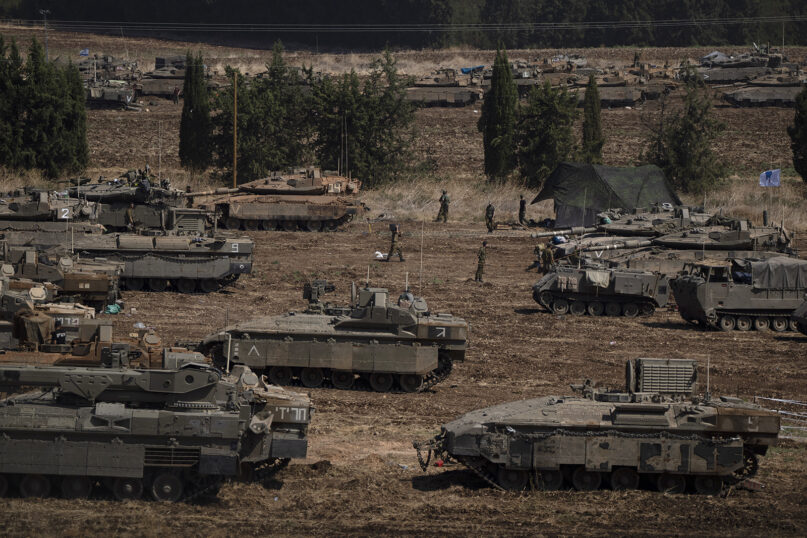(RNS) — The fall semester is underway, and returning with the students are the tensions and controversy that erupted over the Israel-Hamas war last spring. Yet for all the incidents in this wider discourse, I’ll admit a recent rift within the Jewish university community stands out.
This week, new fliers appeared across Harvard’s campus depicting an image of a crying child in Gaza surrounded by rubble and devastation. Underneath the picture is text borrowed from the Yom Kippur Liturgy in both Hebrew and English, stating: anachnu chatanu, we have sinned. These posters were created by a group called the Halakhic Left, a new progressive Jewish organization that seeks to build a home for observant Jews who are against the Israeli occupation of Palestinian territory and who advocate for a cease-fire.
After seeing the posters on campus, the new director of Harvard Hillel, Rabbi Jason Rubinstein, contacted both Harvard and Cambridge police officers because Hillel staff found the posters “intimidating.”
Unbeknownst to him at the time, the posters were put up by Jewish students who wanted to use their voice to denounce the ongoing war in Gaza and now Lebanon. After learning this, Rubinstein announced his most drastic measure yet: Because these students were affiliated with J Street and used Hillel printers to create the fliers, Hillel temporarily suspended J Street U from using its resources, hardening the line over what criticism is acceptable within Hillel’s institutional boundaries. In his message, Rubinstein wrote that he was “shocked when a student betrayed our trust, flagrantly violated the affiliation agreement they had signed just a month earlier, deceived our staff, and misappropriated Harvard Hillel’s funds to produce and distribute these dangerous materials across campus.”
In 1923, Hillel was founded at the University of Illinois to serve Jewish students as more and more Jews entered higher education. Over time, it expanded into the largest Jewish campus organization in the world, spanning multiple continents and all of the major campuses in the United States. According to their website, Hillel seeks to train a new generation of students “so that they may enrich the Jewish people and the world” while being committed to an inclusive vision of Jewish pluralism.
But this mission has always come with problems over who — and what — is included in their vision of Jewish community and the Jewish future.
In 2014, progressive Jewish students organized to create “open Hillels,” organizations that would be more inclusive over which perspectives on Israel could be included within those spaces. In response, then-CEO of Hillel International Eric Fingerhut said Hillel must take a stance of “unequivocal support of Israel” and tightened restrictions on who could speak and be present. This affected Hillels across the country, and in recent years, these controversies have reached their boiling point.
I used to believe in Hillel’s mission of creating a genuinely pluralistic Jewish community. In college, I served as the president of Princeton Hillel’s conservative minyan. We coordinated weekly services that were attended by dozens of students, organized student-run High Holidays and offered learning events with professors from across campus. For anyone who didn’t believe in the future of traditional egalitarian Judaism, I used to point to our community as an example of the hunger for Jewish ritual life.
But even though the community was so vibrant, there were always problems. As the situation in Israel/Palestine worsened, the Princeton Hillel took increasingly radical steps to entrench itself with a pro-Israel consensus to the detriment of Jewish pluralism around Israel. In my freshman year, Hillel hosted “Israel Shabbat,” an event celebrated just months after Israel passed its infamous nation-state law. And in my last semester, the Hillel hosted the president of the Tikvah Fund — a powerful backer of a far-right agenda in Israel — during the height of Netanyahu’s push for a judicial overhaul.
All of this brings me back to what’s happening at Harvard. On a campus riled by discussions of pro-Palestine advocacy and accusations of antisemitism, we have to be sensitive and nuanced with the campus debate. But when Hillel bans Jewish students from using Jewish liturgy to express their legitimate discontent about the war in the Middle East, they abdicate their authority to call out legitimate antisemitism when it does happen. In the process, they force out any Jewish student who, however desperate they are for Jewish community and ritual, will not passively accept their strict stance on the war and Israel.

Israeli soldiers work on tanks and armored personnel carriers in northern Israel, Sept. 30, 2024. (AP Photo/Leo Correa)
In the Yom Kippur liturgy, the machzor reminds us over and over of all the ways we could have better lived up to our values. Rather than “intimidating” community members, these posters use the liturgy to ask a simple question: how have we, consciously or not, failed to support peace and justice over the past year?
Yet days after the anniversary of Hamas’ Oct. 7 attack and the beginning of Israel’s war in Gaza, mainstream Jewish institutions are still unwilling to listen to any critique, while closing ranks against anyone who dissents.
For those who have been forced out of Jewish communities because of their perspective on the war, there are new, growing Jewish spaces waiting to embrace you. These new spaces are working to achieve a simple goal: to offer all Jewish students who fall outside of the pro-war camp a religious home and community.
Within the next decade, Hillel may lose the ability to position itself as the standard bearer of Jewish community on college campuses. And when that happens, don’t say you weren’t warned.
(Zev Mishell is a writer currently studying at Harvard Divinity School. The views expressed in this commentary do not necessarily reflect those of Religion News Service.)














